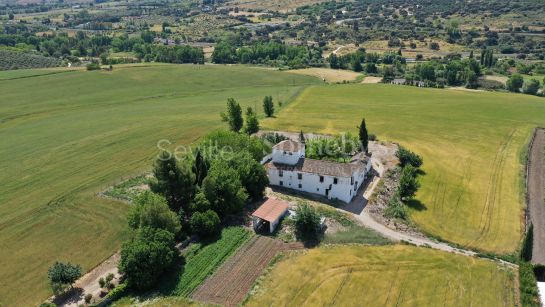Cortijo de la Vizcondesa in Ronda
At the distance of 8 km from Ronda, between fields and olive groves of the Guadalcobacín river valley, you will find a Cortijo with a tradition, history, the so-called Cortijo de La Vizcondesa, its name derives from the former owners, the Viscounts of Torres de Luzón, title granted by Charles II in 1674 to Don Juan Bernardino de Ahumada y Céspedes.
The Cortijo, located on a plot of land of almost 62 hectares, with 46 hectares for labour and the rest for olive groves, and with the possibility of selling in sections, is in perfect working order. The land is of very good quality for farming, with a topsoil of more than 2m thick, with plenty of water and drainage systems, bordering the Guadalcobacín river to the south.
The Cortijo itself is made up of a main house and a house for the farm workers, a chapel, an emblematic tower with a bell tower and a viewpoint overlooking the Ronda mountains, a shed for livestock, two tool rooms and a garden with a swimming pool.
The entrance to the farmhouse is preceded by a wide esplanade, partly paved and partly not, which leads through a simple entrance, flanked by two pillars, to a central courtyard with a round pond, flowerpots and palm trees. At the back of the courtyard, you can see the building, which consists of a solid-looking tower topped by a belvedere with a gallery of lowered semi-circular arches, which houses a bell.
Attached to the tower is a large house, the owners’ two-storey dwelling. On the main floor there is a living room with a fireplace, dining room, bedroom, sitting room, kitchen and bathroom. Upstairs there are 7 bedrooms and a bathroom. At the back of this building there are stables and some outbuildings. At the side of this building is another rectangular-shaped building on a single floor, a house with two bedrooms, a living room with a fireplace, a kitchen and a bathroom.
The closed appearance of the buildings of this farmhouse, as well as the tower with its galleries lead us to believe that the original body of the building was built around the end of the 17th century or the beginning of the 18th century. XVIII century, on which later extensions and alterations were carried out over the years.
This farmhouse is in perfect working order, with its farmland and olive groves, and is also ideal for recreational use.


































